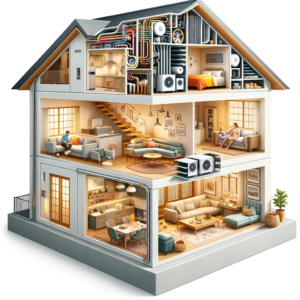Exploring Different HVAC Zoning Systems for Optimal Home Comfort
 In the pursuit of creating an ideal home environment, the concept of HVAC zoning systems has emerged as a transformative solution.
In the pursuit of creating an ideal home environment, the concept of HVAC zoning systems has emerged as a transformative solution.
HVAC zoning is not merely a technical term; it represents a paradigm shift in how we approach home comfort. We want to explain the fundamental definition of HVAC zoning systems, unraveling the intricacies that make it a cornerstone of contemporary living.
Understanding how HVAC zoning systems function and their profound impact on optimizing comfort within our homes is an important key to a personalized, efficient, and tailor-made home climate control.
Understanding HVAC Zoning
HVAC zoning is an approach to home climate control that tailors heating, ventilation, and air conditioning (HVAC) systems to specific areas or “zones” within a residence.
Unlike traditional systems that treat the entire house as a single unit, HVAC zoning allows for personalized temperature regulation in distinct areas, offering a more efficient and customizable solution to meet individual comfort needs.
In a zoned setup, the home is divided into different areas, each equipped with its thermostat and control mechanisms. Zone dampers within the ductwork regulate the airflow to specific zones, ensuring precise temperature adjustments. When a particular area requires heating or cooling, the corresponding thermostat communicates with the HVAC system to activate the necessary components, directing conditioned air solely to that zone. This targeted approach not only optimizes energy consumption but also enhances comfort by allowing different parts of the house to be maintained at different temperatures concurrently.
The benefits of implementing HVAC zoning extend beyond energy efficiency, encompassing enhanced comfort, reduced utility costs, and the flexibility to adapt the home’s climate to the preferences of its occupants.
Types of HVAC Zoning Systems
When it comes to HVAC zoning systems, one size does not fit all. Different types of systems offer varying levels of control and customization, each with its own set of pros and cons. Let’s explore the three primary types: Single-Zone, Multi-Zone, and Hybrid Zoning Systems.
Single-Zone Systems
Pros
Single-zone systems are the simplest and most cost-effective zoning option. They regulate the temperature in the entire house as one unit, making them easy to install and maintain. This approach can be suitable for smaller homes or apartments where individualized temperature control may be less critical.
Cons
However, the simplicity of single-zone systems comes at a cost—lack of flexibility. If different parts of the house have distinct heating or cooling needs, a single-zone system may struggle to provide optimal comfort throughout. It’s a basic solution that may not cater to the diverse preferences of occupants in larger or multi-story homes.
Multi-Zone Systems
Pros
Multi-zone systems divide the house into separate areas or zones, each with its thermostat. This setup allows for more precise control over individual spaces, accommodating varied temperature preferences. Multi-zone systems are ideal for larger homes where different family members may desire distinct climate conditions in various areas.
Cons
While offering greater flexibility, multi-zone systems can be more complex and expensive to install. The need for additional thermostats and zone dampers in the ductwork contributes to the upfront costs. Maintenance and troubleshooting can also be more intricate compared to single-zone systems.
Hybrid Zoning Systems
Pros
Hybrid zoning systems combine aspects of both single-zone and multi-zone setups, offering a balanced solution. They provide the simplicity of a single-zone system in certain areas while allowing for customizable climate control in others. This flexibility makes hybrid systems suitable for homes with a mix of open and closed-off spaces.
Cons
The challenge with hybrid systems lies in finding the right balance. Designing an effective hybrid system requires careful consideration of the home’s layout and the specific needs of its occupants. Installation costs may also be higher than single-zone systems, though they typically remain more reasonable than fully-fledged multi-zone setups.
Understanding the pros and cons of each HVAC zoning system is crucial for homeowners looking to optimize comfort and energy efficiency. The choice depends on factors such as home size, layout, and individual preferences, with each type offering a unique approach to achieving the perfect indoor climate.
Components of HVAC Zoning Systems
Zone Dampers
At the core of HVAC zoning systems are zone dampers, small yet mighty devices seamlessly integrated into the ductwork. Picture them as traffic controllers for conditioned air. These dampers regulate airflow to specific zones, intelligently opening and closing to ensure that each area receives the perfect dose of heating or cooling. This dynamic functionality transforms a conventional HVAC system into a tailored solution, allowing homeowners to steer comfort precisely where it’s needed.
Thermostats and Controls
Unlike the traditional one-size-fits-all thermostat, each zone boasts its own thermostat, putting the power of temperature adjustment directly into the hands of the homeowner. This granular control not only caters to individual preferences but also champions energy efficiency. Whether programming a schedule for optimal comfort or making real-time adjustments through a user-friendly interface, these components empower users to curate their indoor environment with ease.
Ductwork Modifications
Behind the scenes, ductwork modifications serve as the architectural backbone of effective HVAC zoning. It’s akin to customizing the highways through which conditioned air travels. Zone dampers are strategically placed within the ducts, and tweaks may be made to the overall layout to ensure that each zone receives its fair share of comfort. These modifications, though technical, are instrumental in preventing energy waste and maximizing the efficiency of the system. By optimizing the airflow pathways, ductwork modifications ensure that the right amount of conditioned air reaches the right destination, contributing to a finely tuned and energy-conscious home climate.
Smart Home Integration
In the era of smart living, HVAC zoning systems have embraced the future with smart home integration. Imagine controlling your home’s temperature from the palm of your hand or with a simple voice command. Smart thermostats and controls take HVAC zoning to the next level by allowing homeowners to manage their system remotely. This not only enhances convenience but also contributes to energy savings.
Factors to Consider When Choosing HVAC Zoning
Home Size and Layout
The size and layout of your home emerge as key considerations when researching about HVAC zoning and your home.
A compact apartment with an open layout may find a simple single-zone system sufficient, while larger homes with multiple floors benefit from the nuanced control of multi-zone setups.
Understanding how the spaces in your home interact and differ in heating and cooling needs lays the foundation for choosing the most effective zoning configuration. It’s like tailoring a suit – the fit matters, and in this case, the fit is all about achieving optimal comfort in every nook and cranny of your living space.
Climate Considerations, Energy Efficiency, and Budget Constraints
Beyond your home’s physical characteristics, the climate in your region plays a significant role in deciding the type of HVAC zoning that suits you best.
Cold winters and scorching summers may demand a more sophisticated zoning approach to combat extreme temperature variations. Energy efficiency joins the conversation as a crucial factor. Zoning systems can contribute to significant energy savings by directing conditioned air precisely where it’s needed, preventing unnecessary heating or cooling.
However, these advancements come with costs, and aligning the benefits with your budget is key. Balancing climate considerations, energy efficiency goals, and budget constraints ensures that your HVAC zoning choice aligns seamlessly with both your comfort aspirations and financial realities.
Conclusion
In the pursuit of optimal home comfort, the exploration of HVAC zoning systems has illuminated a path toward a more personalized and efficient living environment. What began as a quest to understand the fundamental definition of HVAC zoning systems evolved into a journey through the intricate components and diverse types of zoning solutions available. From single-zone simplicity to the nuanced control of multi-zone systems and the balanced approach of hybrid systems, homeowners now have an array of choices to tailor their indoor climate.
As we conclude our exploration, it’s clear that the effectiveness of HVAC zoning is not a one-size-fits-all affair. Factors like home size, layout, regional climate considerations, energy efficiency goals, and budget constraints are the compass guiding homeowners toward the most suitable zoning solution. Whether you’re envisioning a sleek single-zone setup, a sophisticated multi-zone configuration, or the adaptability of a hybrid system, the power to curate your home’s climate is in your hands.
In embracing the future, smart home integration adds an extra layer of convenience and energy savings, showcasing the dynamic evolution of HVAC zoning systems. So, as you embark on the exciting journey of selecting the perfect HVAC zoning system for your home, remember that the key lies in finding the harmony between your comfort aspirations and the practicalities of your living space. With HVAC zoning, you’re not just adjusting temperatures; you’re crafting an ideal haven tailored to your unique preferences and needs.


 Jacobs and Rhodes
Jacobs and Rhodes